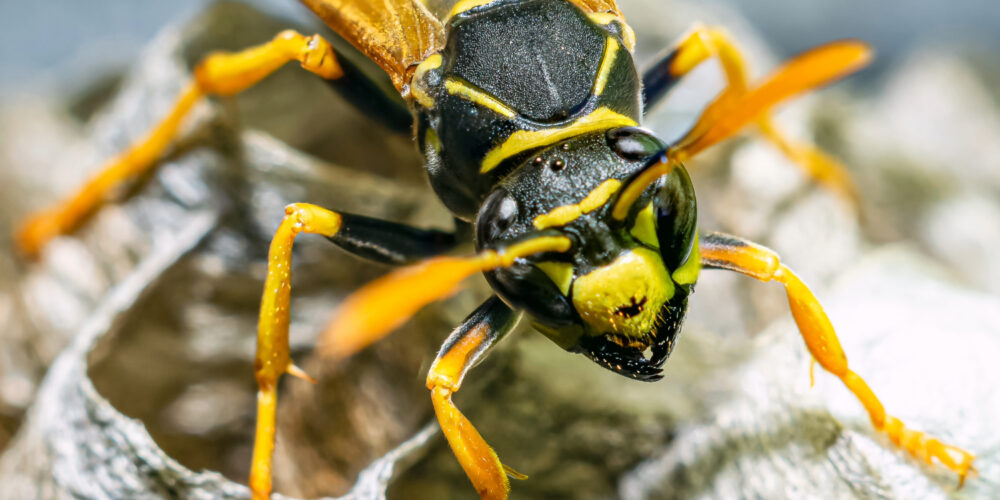Wasps can be aggressive and territorial, especially near homes and high-traffic areas. Here’s a breakdown of the species we see in Southern Utah:
1. Paper Wasps
- Appearance: Slender body, brown with yellow or reddish markings
- Behavior: Generally non-aggressive unless their nest is disturbed, build open, umbrella-shaped nests under eaves, patio roofs, and porch ceilings
- Danger: Can sting multiple times and will defend their nest aggressively, can cause allergic reactions leading to anaphylaxis
2. Yellowjackets
- Appearance: Stocky, bright yellow and black with short legs
- Behavior: Extremely aggressive, especially in late summer and fall, often build hidden nests underground, in wall voids, or in attics
- Danger: Can sting repeatedly and are responsible for most wasp stings in the U.S., can cause allergic reactions leading to anaphylaxis
3. Hornets
- Appearance: Larger than other wasps, typically black and white (e.g., bald-faced hornet)
- Behavior: Highly defensive of their nests, quick to sting when threatened, large, football-shaped paper nests in trees, shrubs, or on buildings
- Sting Risk: Painful stings; can be dangerous in large numbers, can cause allergic reactions leading to anaphylaxis
4. Mud Daubers
- Appearance: Thin, thread-waisted with metallic black or blue bodies
- Behavior: Solitary and non-aggressive; rarely sting, construct tubular mud nests on walls, under eaves, or in garages
- Risk: Although not dangerous, their nests can be unsightly and attract other pests
What About Honeybees?
We do not treat or exterminate honeybees, and here’s why:
- Importance to the Environment: Honeybees are essential pollinators for plants, crops, and ecosystems
- Protected Status: In many areas, it’s illegal or discouraged to harm honeybee colonies
- Our Policy: If you have honeybees on your property, we’ll help you connect with a licensed beekeeper or ethical relocation service
Why Wasps Are a Serious Problem
- Aggressive Defenders: Most wasps will sting to protect their nest, often multiple times
- Allergy Risk: Wasp stings can cause severe allergic reactions, including anaphylaxis
- Recurring Nests: Once they nest in a spot, wasps often return year after year
- Nests in Dangerous Places: Wasps often build nests in places where people live, play, or work
- Hostile to Pollinators: Wasps often target native pollinators and can cause harm to the environment.
Our Wasp Treatment: Nest Removal + Nest Site Prevention
We take a proactive and responsible approach to handling wasps.
Our Process:
- Inspection: Identify species and locate nests
- Nest Removal: Carefully remove active or abandoned nests from eaves, attics, trees, playsets, or other structures
- Perimeter Treatment: Apply a residual, eco-friendly treatment to discourage re-nesting
- Void treatment: Inject long lasting product in entry-points to hidden nests on soffits, patios, and other structures
- Prevention Tips: We’ll show you how to reduce attractants and future nesting behavior
- Warranty: If a new nest appears call us and we will remove it for no extra charge
Why Our Method Works:
- Fast & Effective: We remove the problem at its source.
- Safe for People & Pets: Treatments are targeted and applied with care
- Reduces Repeat Nests: Our treatment helps deter future wasp activity in the same areas

